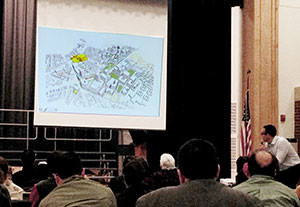By Josie Grove

Somerville residents were briefed on the latest developments in the SomerVision Union Square neighborhood plan at a public meeting held last week at the Argenziano School. ~Photo by Josie Grove
The plan for the Union Square neighborhood’s redevelopment is far from finished, but residents are getting impatient. At a meeting last Thursday in the Dr. Albert F. Argenziano cafeteria, Somerville’s Director of Planning George Proakis presented updates and clarifications on the Union Square neighborhood plan.
A neighborhood plan is an aspirational document, said Proakis, which will guide the balance of commercial space, residential space, and open space in the neighborhood. The neighborhood plan will inform the zoning restrictions on land in Union Square, and guide the city’s thinking about public space and the overall ‘feel’ of the neighborhood.
SomerVision, the twenty-year plan for citywide development, will inform much of the balance of commercial and residential development in Union Square. “The goal of SomerVision was to establish a balance, or rather to re-establish a balance of the city’s jobs to its workforce,” said Proakis. Each job brings a worker, Proakis continued, and balancing the number of jobs to the number of housing units will be critical. The balance is not isolated to Union Square, rather, development in Union Square must respond to citywide imbalances.
“It’s easier to build housing than it is to create jobs, but we don’t want to have areas that are all residential or all commercial,” said Proakis. The planning department is wrestling with what ratio they will use to determine the meaning of commercial and balance, in order to assure that every new worker brought to Somerville would be able to find housing.
The ratio of open space to developed area is also informed by SomerVision, which aims to create 125 acres of open space in the Union Square area by 2030. “Since 2010, about thirty-two acres of land are more or less established toward that goal,” said Proakis.
Somerville only plans to create a few acres of city-owned open space. Zoning will require that developments be 15% open space, or that developers pay towards development of open areas elsewhere. “We are taking the strictest, highest-quality definition of open space of any code that I have seen,” said Proakis of the requirements. “[The zoning] will create places where people want to be, not medians or highway strips.” The precise nature of the city-controlled space has yet to be determined. The planning department is weighing variations of a large central park against numerous smaller squares. The residents will have opportunity for further input as the plan develops.
Neighbors attending the meeting had a litany of questions and comments.
One set of questions concerned rumors of the city taking portions of Allen Street by eminent domain. “There is no plan and no interest in taking land on Allen Street by eminent domain,” said Proakis.
The other set of questions came from Union United Coalition, a group of local stakeholders who want the development of Union Square to not displace current residents and businesses. The group had expected the plan to be more specific and more developed, and were visibly frustrated that their goals of affordable housing and transit in Union Square were not addressed at this stage.
Transit, and the over-budget Green Line Extension, cast a shadow over the meeting, and Proakis addressed it briefly. “The Green Line delay causes its fair share of hiccups, but for us for neighborhood planning it’s best for us to plow ahead,” he said. “We are trying to establish yet one more reason why the green line is a benefit to us.” The Union Square spur of the Green Line is one of the conditions for $1 billion of Federal Transportation Administration funding.
“A finishing of a plan can be looked at as another beginning,” said Proakis, “The beginning of implementation and evaluation. “There’s many more hours of community participation to go and issues to address,” said Proakis. Even after the plan is made final, Proakis said, there will still be opportunity for community input.
















Reader Comments